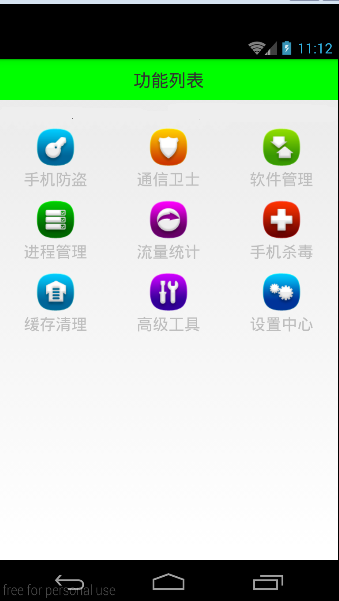編輯:Android開發實例
android 中有三個經常使用的容器:LinearLayout、RelativeLayout、TableLayout。下面分別簡單的介紹一下每個容器。
1、LinearLayout 組件或子容器水平或垂直線性排列。有5個基本屬性:
a、android:orientation 值為horizontal時為水平的,值為vertical 時為垂直的。
b、LinearLayout裡面的組件都有android:layout_width和android:layout_height 屬性。
c、android:layout_weight控制組件的比例。
d、android:layout_gravity 控制組建的初始順序。
e、padding 邊緣。
LinearLayout簡單的xml文件為:
<?xml version="1.0" encoding="utf-8"?>
<LinearLayout
xmlns:android="http://schemas.android.com/apk/res/android"
android:orientation="vertical"
android:layout_width="fill_parent"
android:layout_height="fill_parent"
>
<RadioGroup
android:orientation="horizontal"
android:layout_width="wrap_content"
android:layout_height="wrap_content"
android:padding="5px">
<RadioButton
android:text="RadioButton1" />
<RadioButton
android:text="RadioButton2" />
</RadioGroup>
<RadioGroup
android:orientation="vertical"
android:layout_width="fill_parent"
android:layout_height="wrap_content"
android:padding="5px">
<RadioButton
android:text="RadioButton1" />
<RadioButton
android:text="RadioButton2" />
<RadioButton
android:text="RadioButton3" />
</RadioGroup>
</LinearLayout>
2、RelativeLayout 根據組件之間的關系以及組件和容器的關系排列
a、組件與容器的關系
屬性為:android:layout_alignParentTop、android:layout_alignParentBottom、android:layout_alignParentLeft、android:layout_alignParentRight、android:layout_centerHorizontal、android:layout_centerVertical、android:layout_centerInParent
b、組件之間的關系
屬性為:android:layout_above、android:layout_below、android:layout_toLeftOf、android:layout_toRightOf等。
RelativeLayout的簡單的例子的xml 文件為:
<?xml version="1.0" encoding="utf-8"?>
<RelativeLayout
xmlns:android="http://schemas.android.com/apk/res/android"
android:layout_width="fill_parent"
android:layout_height="wrap_content"
android:padding="5px">
<TextView android:id="@+id/label"
android:layout_width="wrap_content"
android:layout_height="wrap_content"
android:text="URL:"
android:paddingTop="15px"/>
<EditText
android:id="@+id/entry"
android:layout_width="fill_parent"
android:layout_height="wrap_content"
android:layout_toRightOf="@id/label"
android:layout_alignBaseline="@id/label"/>
<Button
android:id="@+id/ok"
android:layout_width="wrap_content"
android:layout_height="wrap_content"
android:layout_below="@id/entry"
android:layout_alignRight="@id/entry"
android:text="OK" />
<Button
android:id="@+id/cancel"
android:layout_width="wrap_content"
android:layout_height="wrap_content"
android:layout_toLeftOf="@id/ok"
android:layout_alignTop="@id/ok"
android:text="Cancel" />
</RelativeLayout>
3、TableLayout
一個簡單的例子的xml文件為:
<?xml version="1.0" encoding="utf-8"?>
<TableLayout
xmlns:android="http://schemas.android.com/apk/res/android"
android:layout_width="fill_parent"
android:layout_height="fill_parent"
android:stretchColumns="1">
<TableRow>
<TextView
android:text="URL:" />
<EditText android:id="@+id/entry"
android:layout_span="3"/>
</TableRow>
<View
android:layout_height="2px"
android:background="#0000FF" />
<TableRow>
<Button android:id="@+id/cancel"
android:layout_column="2"
android:text="Cancel" />
<Button android:id="@+id/ok"
android:text="OK" />
</TableRow>
 Android 圖片縮放與旋轉的實現詳解
Android 圖片縮放與旋轉的實現詳解
本文使用Matrix實現Android實現圖片縮放與旋轉。示例代碼如下:代碼如下:package com.android.matrix;import androi
 Android手機衛士(一):實現splash
Android手機衛士(一):實現splash
從今天開始根據之前學習的android的基礎知識,實戰一下,實現一個簡單功能的android手機衛士。 手機衛士的主要功能如下: 什麼是Spla
 Android IMF開發實例(SoftKeyboard)深入剖析
Android IMF開發實例(SoftKeyboard)深入剖析
Android IMF(Input Method Framework)是自An
 Android加載Spinner
Android加載Spinner
可以顯示在的Android任務,通過加載進度條的進展。進度條有兩種形狀。加載欄和加載微調(spinner)。在本章中,我們將討論微調(spinner)。Spinner 用